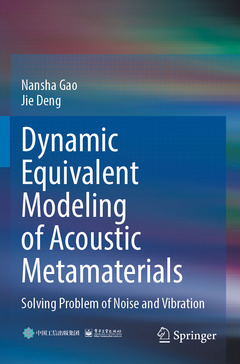Description
Dynamic Equivalent Modeling of Acoustic Metamaterials, 1st ed. 2022
Solving Problem of Noise and Vibration
Authors: Gao Nansha, Deng Jie
Language: English
Subjects for Dynamic Equivalent Modeling of Acoustic Metamaterials:
Approximative price 105.49 €
In Print (Delivery period: 15 days).
Add to cartPublication date: 10-2023
176 p. · 15.5x23.5 cm · Paperback
Approximative price 158.24 €
In Print (Delivery period: 15 days).
Add to cartPublication date: 10-2022
176 p. · 15.5x23.5 cm · Hardback
Description
/li>Contents
/li>Biography
/li>Comment
/li>
This book derives physical models from basic principles, studies the effect of equivalent models on the dynamic characteristics of phononic crystals and acoustic metamaterials, and analyzes the physical mechanisms behind vibration and noise reduction. It first summarizes the research status of vibration and noise reduction, and research progress in phononic crystals and acoustic metamaterials. Based on this, one-dimensional periodic beam, two-dimensional thin plate with circular hole, and corresponding gradient structures are introduced, and their dynamic characteristics are discussed in detail. Therefore, different equivalent methods for different models are proposed through theoretical analysis, modal analysis and transmission rate analysis. Finally, a Helmholtz-type acoustic metamaterial, i.e. a multi-layer slotted tube acoustic metamaterial, is studied. Aiming at the low-frequency band gap of this model, a theoretical model for solving the inverse problem of acousto-electric analogue equivalent is proposed, and the effect of structural parameters on the low-frequency band gap is studied using this equivalent model.
Nansha Gao is currently Associate Professor in School of Marine Science and Technology, Northwestern Polytechnical University, P. R. China. He received the B.E. degree in process equipment and control engineering from Northwest University, China, in 2010, the Ph.D. degree in mechanical engineering from Xi’an JiaoTong University, China, in 2016.
Prof. Gao has published over 40 International SCI. journals; 22 International and Domestic patents; and 3 academic monographs. He presided 8 research funds, including National Natural Science Foundation of China, et al. Prof. Gao’s research interests includes materials physics, sound wave control, and acoustic metamaterial design.<
Proposes theoretical model for inverse problem solving of acoustic metamaterials
Presents inverse model of dynamic equivalent medium of acoustic metamaterials
Gives model for inverse problem solving of Helmholtz-type acoustic metamaterial analogical equivalent model




